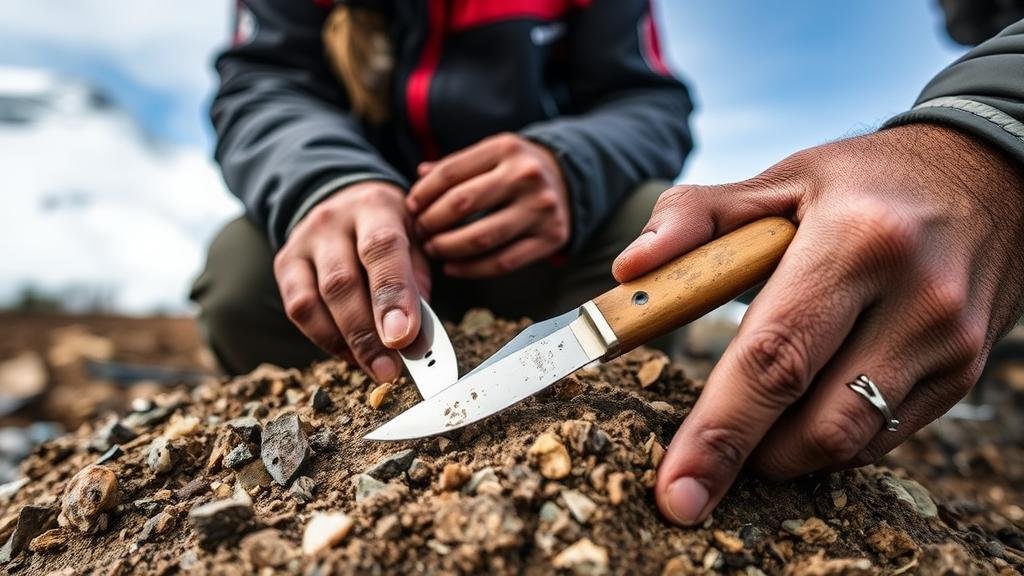Unearthing Flint Knives and Tools in High-Altitude Hunting Camps
Unearthing Flint Knives and Tools in High-Altitude Hunting Camps
The study of prehistoric human habits reveals much about their subsistence strategies, and the excavation of flint knives and tools in high-altitude hunting camps is a compelling area of research. These artifacts provide insight into ancient technologies and adaptations to rugged environments. High-altitude locations, often characterized by demanding weather conditions and a lack of resources, challenge our understanding of early human behavior and technological advancement.
The Importance of Flint in Prehistoric Toolmaking
Flint has been a preferred material for tool-making due to its availability, workability, and the sharp edges it can produce when struck. Archaeologically, flint tools such as knives, scrapers, and projectile points are classified based on their shapes and intended uses. For example, the classic Clovis point, a fluted spearpoint made from flint, highlights the sophistication of early humans in creating effective hunting tools.
Statistically, studies show that flint tools account for approximately 75% of the stone tools recovered from archaeological sites worldwide. This high percentage indicates not only a preference for flint but also its essential role in the daily lives of prehistoric communities, especially in high-altitude hunting camps where efficiency and effectiveness in hunting could drastically affect survival.
High-altitude hunting camps present unique challenges, including sparse vegetation, fluctuating temperatures, and limited access to water and other vital resources. Anthropologists suggest that these camps often served as seasonal hunting grounds for early humans, particularly during migrations of large game species. The adaptation to such environments showcases the resilience and ingenuity of prehistoric populations.
For example, archaeological findings at the Alpine site of Chamois Glacier reveal an array of flint tools alongside the remains of mountain goats. The site, located at over 3,000 meters, gives evidence that these tools were specifically adapted for high-altitude conditions where mobility and strategic hunting were critical for food procurement.
Excavation Techniques and Discoveries
The excavation of flint tools in high-altitude camps requires meticulous planning and execution ensure the preservation of the artifacts and the context in which they were found. Archaeologists typically employ techniques such as stratigraphic excavation, which allows for the systematic removal of soil layers to understand the chronological placement of artifacts.
- Use of GPS and GIS technology for accurate site mapping
- Remote sensing techniques to identify potential archaeological hotspots
- Careful removal of overburden to prevent damage to fragile artifacts
These methods have led to significant discoveries, such as the excavation at the site in the Rocky Mountains, where researchers uncovered a cache of flint knives dating back over 8,000 years. This particular find included tools specifically designed for butchering, offering insights into the subsistence patterns of the inhabitants.
Case Studies: Notable Archaeological Sites
Several high-altitude sites have yielded important artifacts that illuminate prehistoric life. One notable case is the findings at the Sawtooth Wilderness Area in Idaho. Excavations here revealed a wealth of flint tools alongside animal remains, with radiocarbon dating placing the site at around 5,000 years old. The presence of specialized hunting tools, including barbed points, indicated that the inhabitants were not just opportunistic hunters but possessed advanced hunting strategies.
Also, the discovery at the Bitterroot Mountains site further supports the notion of seasonal hunting camps used by early people. Artifacts such as scraper tools provide evidence of skin processing for clothing and shelter, illustrating a complex understanding of sustainable living in high-altitude regions.
Conclusion: Implications for Understanding Prehistoric Cultures
The study of flint knives and tools in high-altitude hunting camps significantly enriches our understanding of prehistoric cultures. e artifacts not only offer a glimpse into the technologies used by ancient people but also underscore their adaptive strategies in extreme environments. As research continues, there is a strong indication that these findings will help reconstruct the social and ecological dynamics of past populations.
Future excavations and technological advancements promise to unveil even more insights into the life and times of high-altitude hunters. As we unearth these ancient tools, we gain a better appreciation of the ingenuity and resourcefulness of our ancestors.
Actionable Takeaways
- Engage with local archaeological programs to support the preservation of sites.
- Promote awareness of the significance of ancient tools in understanding human history.
- Consider the importance of sustainable practices mirrored by ancient populations for modern conservation efforts.



